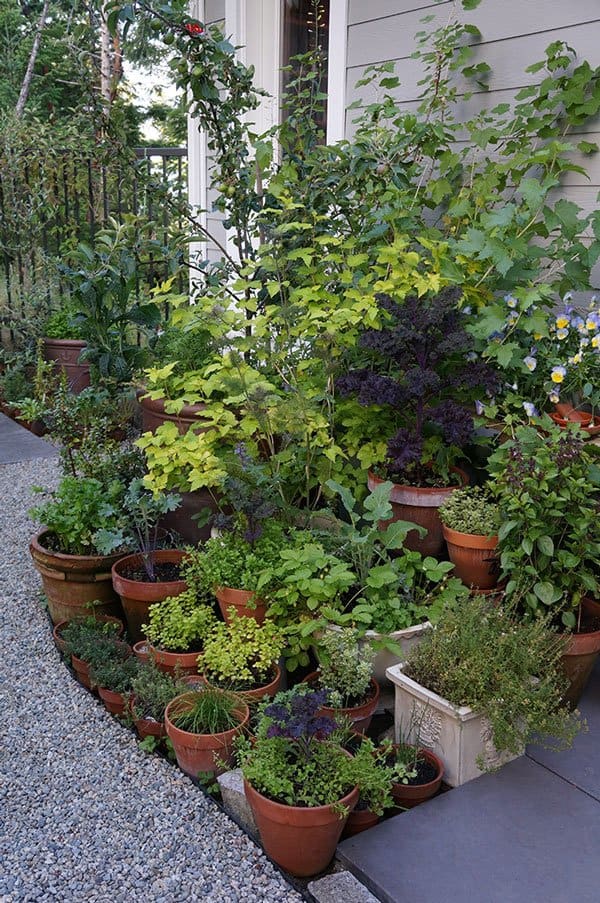
I’m always amazed by how much food I harvest ongoingly from our patio planters. I pop back and forth from kitchen to garden throughout the summer to pick strawberries, blueberries, currants — even figs and apples — from a cluster of terracotta pots outside the back door. And thanks to the slipper-friendly gravel leading to it, I don’t even need to bother putting on shoes when I run out for quick pickings from my kitchen garden using container gardening.
Even more gratifying than the summer flush of fruits and berries is the year-round nourishment provided by the edible groundcovers that act as a living mulch in the planters. While dwarf-sized trees and a variety of bushes stand tall as “thriller” feature plants and provide crops seasonally, the “fillers” and “spillers” surrounding them feed my family annually at every meal, providing flavours any foodie would appreciate. These groundcovers are the true workhorses of this edible container garden, keeping weeds to a minimum and, in the case of aromatic herbs, even deterring insect pests, all while looking gorgeous and adding texture and colour to the garden and table.
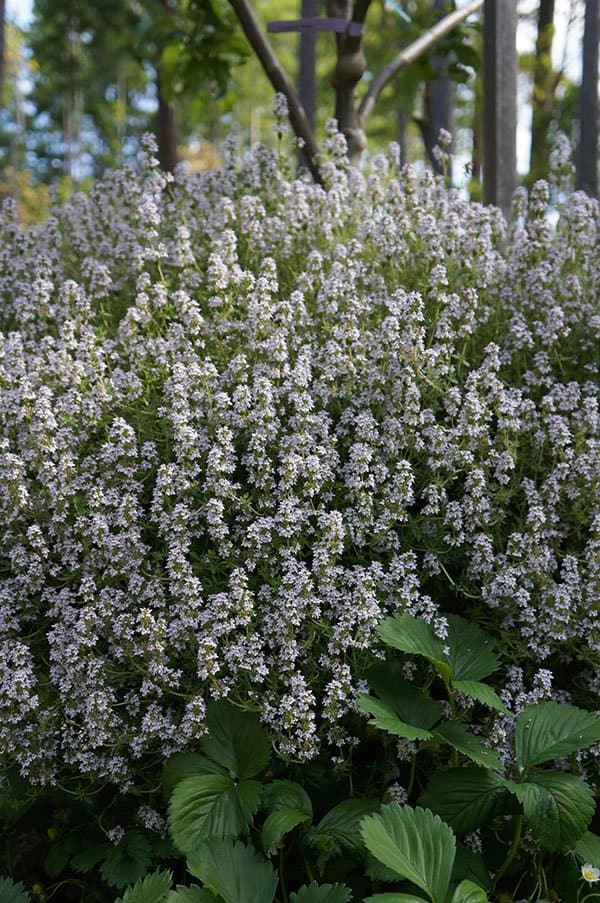
English thyme
While a multi-grafted dwarf apple tree in a giant terracotta pot gifts us annually in late summer with a small bounty of fruit, we take snippings just about every day from the prolific bed of perennial Thymus vulgaris (Zone 4) that surrounds it. Strewn onto toast with goat’s cheese or over an omelette, fresh thyme leaves and flowers transform the ordinary into the extraordinary.
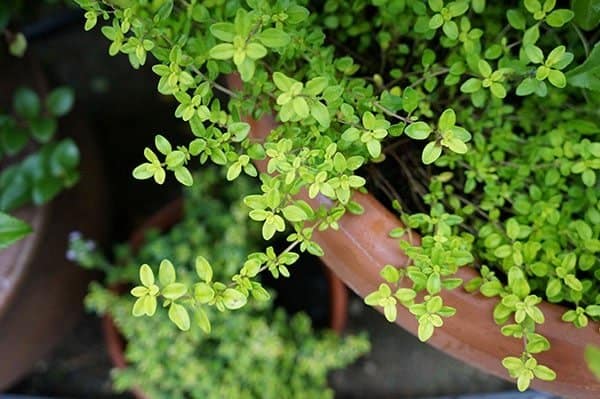
Gold thyme
Thymus praecox ‘Evergold’ is dazzling in the garden or as part of any savoury offering. Hardy to Zone 5, this spiller endures drought and keeps its beautiful colour despite relentless summer sunshine.
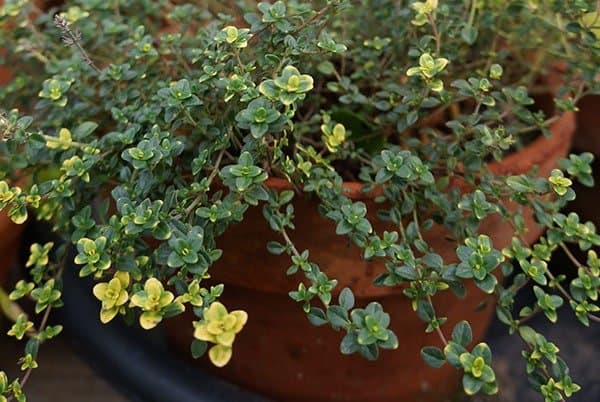
Lemon thyme
Delicious with fish, in marinades or as part of any dish that benefits from a whiff of lemon, beautiful Thymus × citriodus can also be rubbed onto your skin to make you smell great. Hardy only to Zone 7, it can be kept in a small pot and brought inside for the winter.

Greek oregano
“True” oregano (Origanum vulgare ssp. hirtum) is originally from the mountains of Greece and hardy to Zone 5. Don’t let its plain-Jane appearance fool you — it’s the most sumptuous of the oreganos, and what you want to have on hand for any authentic Greek dishes you prepare.

Golden oregano
Visually stunning, Origanum vulgare ‘Aureum’ is my favourite filler. Equally cold-hardy to Greek oregano, its luminous leaves shine out year-round in the garden. For maximum impact, grow it around a giant ‘Redbor’ kale in a medium-sized pot, and serve the two together in an enticing salad.
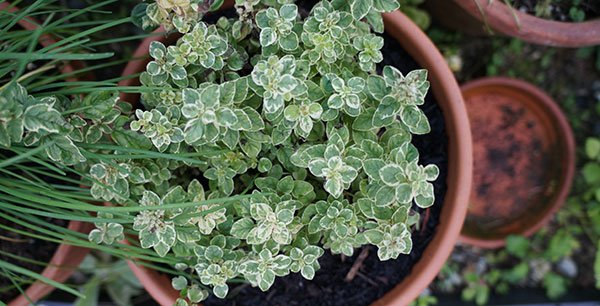
Variegated marjoram
Despite its low, prostrate growth, the vivid foliage of Origanum marjorana ‘Variegata’ (Zone 4) makes it distinctive enough to hold its own as a thriller in a small pot or as a filler in a larger display. With flavour similar to common marjoram, it’s a must for potato soup, stuffings and stews.
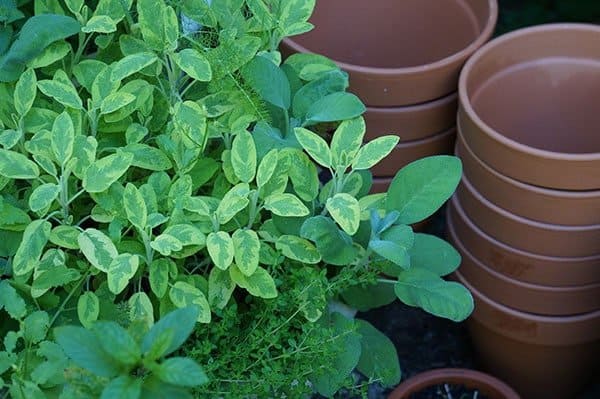
Sage
The many varieties of Salvia officinalis are generally hardy to Zone 5, and work well as a filler planting around a potted tree or make it the main event in a smaller pot. Frequent trimming keeps sage from becoming too shrubby, and allows you to keep the larder stocked with fresh and dried leaves. Make browned butter and sage to go with mashed sweet potatoes or buzz it in the blender with toasted hazelnuts to make a tasty pesto.
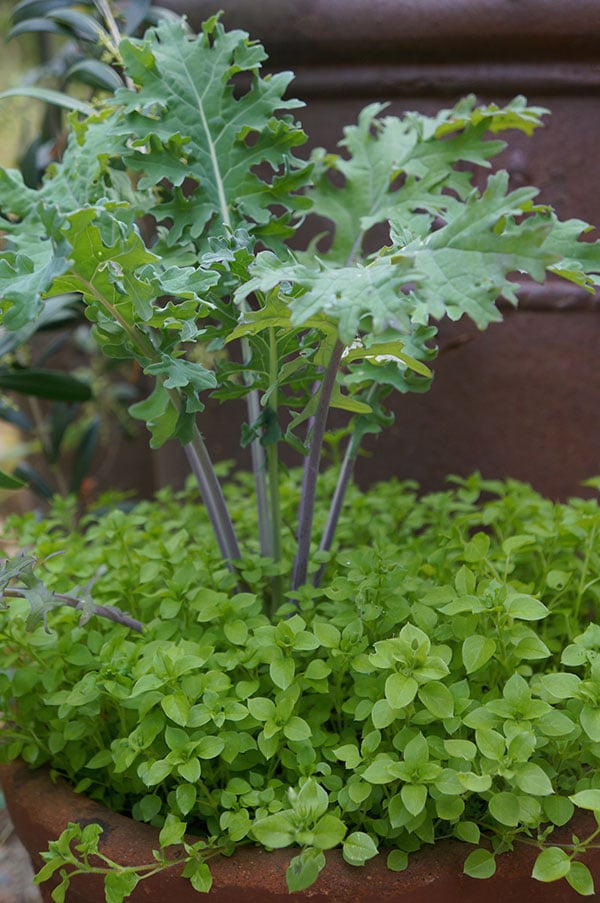
‘Red Russian’ kale
A prolific self-seeder, ‘Red Russian’ kale can be grown as a leafy filler or as low-growing microgreens to be scissor-snipped regularly for quick, super-healthy greens. When your crop starts looking less lush, simply harvest it all and reseed. Your groundcover will reappear within a couple of weeks. [See also: 9 beautiful kales to grow]
Chickweed
Yes, I am talking about a weed. Chickweed (Stellaria media) makes an admirable filler in any container planting, providing a cloud of fluffy green foliage and tiny star-like flowers. Shear it regularly for salads, soup greens, pesto or smoothies to keep it from becoming seedy and scraggly. If you doubt the value of letting a weed proliferate, check out herbalist Susun Weed’s Healing Wise, which gives chickweed full points for relieving inflammation, cleansing the liver, improving hepatic circulation, boosting digestion, and cooling and alkalinizing the body. And it tastes good, too.
More about edible garden plants and container gardening
- See our posts in Food to Grow
- See our posts on Container Gardening

Can the herbs be left in the containers overwinter? or should they be put in a protected place?
Loved reading your article. I also grow all kinds of herbs that I use regularly in salads.
I felt “I am going to do this after reading Edibles kit hed Garden in Containers; however I will include a favourite Basil in my group of pot tables. Thanks for the continuing “doable ” articles .Very uplifting and well, full of joy!
Thanks